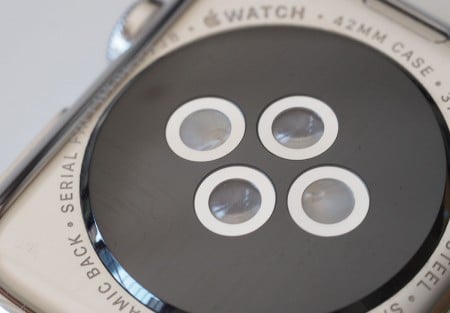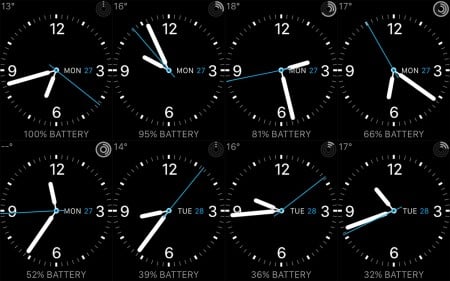Catch two: battery life
One of the biggest problems with any smart device is battery life. In fact, ignore the whole smart device thing, and apply it to modern electronics, with the more technology thrown into a gadget, the worse battery life you getting out of it.
You want a nice screen, an accelerometer, high-speed mobile connectivity, and small size?
Something’s gotta give, and that something will likely be the battery life.

Every smartwatch seems to succumb to this problem, the burden of lasting as long as a conventional watch, or long enough to not need a charge every day or two, and the Apple Watch is no different.
In our tests, though, we found two models of battery life, with one for the person who treats the Watch as if it’s brand new, shiny, and always supposed to be used, while the other model is for people who treats the Watch like, you know, a watch.
That first model will be everyone who buys the watch for the first few days.
Here are the thoughts of an Apple Watch buyer for at least the first 24 hours:
ZOMG! I have an Apple Watch! This is the future on my wrist! LOLOLOLOL! Look at that screen! And the build! I just want to poke and prod and touch and hold this thing for the rest of my life. I’m totally going to explore all the apps, and download games, and use this all the time! It’s just so awesome! ZOMG!
The next day, you might actually get to use the Watch for more than just exploring and poking and prodding. You’ll use the apps when and where you want to, not just because you spent between $500 and $25,000 on the watch and you need to get your money’s worth.
You’ll check bus times with Trip View, you’ll open Instagram on the bus and read your activity feed, you can read the message the partner sent you about getting something for dinner and then browse the groceries at Woollies via the watch itself. When you get off the bus to buy something, you can quickly check your bank balance by loading the app for your bank.
And when it’s all over and the partner calls to check on you buying dinner which you’ve just done, you don’t need to pull the phone out of your pocket and can simply answer it by speaking into the minute speakerphone on your wrist. When you’re done, you’ll check the time, and wonder how you got by doing all of this without a smartwatch in your life, previously checking your phone, which is still in your pocket doing all of the heavy lifting.
This is a watch that provides that experience: an out-of-pocket smartphone experience with just enough of the phone uses you need without fumbling for the wide smartphone in a cotton-lined pocket or inside a handbag.
In that scenario, you’ll want to charge the Apple Watch nightly, with a test of regular and frequent use of the Apple Watch yielding a day, with a charge every time you go to bed.
Then there’s the second model, and this is what we became shortly after our “ZOMG” moment.
Yes, some people will treat the Apple Watch for what it is: a watch.
You’ll check the time when you need to, and when someone sends your phone a message, you’ll check it on your Apple Watch, reading it, and possibly sending back a simple message in return, but deciding not to use Siri to translate your voice and using your phone instead. On-screen keyboards are faster and more reliable, you think to yourself, and you’d be right.
You might check the watch a few more times throughout the day, but you always take phone calls on your phone because speaking into your wrist makes you look a bit like an idiot, and no one wants to listen to your conversation in public, regardless of how Dick Tracy-esque you fancy yourself. Plus, when Samsung’s watch did it, you criticised it back then, so why conform now?
And so you use your watch as a watch, and you occasionally deal with notifications and what not, and the occasional app checking, but it’s a watch that notifies you of important things, not just the importance of the time.
In that scenario, you’ll find a full day of life on the Watch is easy to deal with, and depending on how light your usage is, depending on how watch-like your experience is, you might even get two days, switching the power saving mode halfway through the second day. That was us, and by midday the second day, we had a little under 30% left, allowing us to go into power saving and keep the phone going until we found a charger.
Overall, a maximum of two days isn’t bad with the Apple Watch, especially since most smartwatches struggle to offer more than a day. In comparison, this is a fine result against the LG G Watch R, which we can keep going for two days until it needs to be charged, with a similar effort found on the Sony SmartWatch 3.

But where most people will deal with the issue of battery life will be those coming from the idea that a watch should last days, weeks, months, and years before a battery needs to be replaced.
That’s typical with a conventional watch, mechanical or digital, and comes from there being no smarts, no wireless connectivity talking to a phone or computer, no operating system, no full colour display, no multimedia playback, and no vibration engine. These parts are all bigger and hard to throw into a small and slim-line watch without the battery suffering, which some might call a day or two of life max.
That being said, Apple’s one to two days is acceptable, especially given what else is out there right now, what it competes against, because this isn’t supposed to compete against the long-lasting battery life of your Skagen or Rolex or Casio or Timex.
This is different. It’s a smartwatch, not just a watch.










